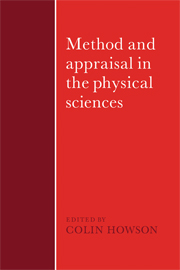Book contents
- Frontmatter
- Contents
- Editorial preface
- History of science and its rational reconstructions
- Atomism versus thermodynamics
- Thomas Young and the ‘refutation’ of Newtonian optics: a case-study in the interaction of philosophy of science and history of science
- Why did oxygen supplant phlogiston? Research programmes in the Chemical Revolution
- Why did Einstein's Programme supersede Lorentz's?
- The rejection of Avogadro's hypotheses
- On the critique of scientific reason
- Index of Names
Thomas Young and the ‘refutation’ of Newtonian optics: a case-study in the interaction of philosophy of science and history of science
Published online by Cambridge University Press: 04 August 2010
- Frontmatter
- Contents
- Editorial preface
- History of science and its rational reconstructions
- Atomism versus thermodynamics
- Thomas Young and the ‘refutation’ of Newtonian optics: a case-study in the interaction of philosophy of science and history of science
- Why did oxygen supplant phlogiston? Research programmes in the Chemical Revolution
- Why did Einstein's Programme supersede Lorentz's?
- The rejection of Avogadro's hypotheses
- On the critique of scientific reason
- Index of Names
Summary
Introduction
A great scientific revolution occurred in optics in the early part of the nineteenth century when the Newtonian corpuscular theory of light was rejected in favour of the wave theory. The majority of scientists became convinced of the superiority of the wave theory in the late 1820s to early 1830s, yet many historians and commentators have claimed that the superiority of the wave theory had already been established by the work of Thomas Young published in the first years of the 1800s. Hence there arises a famous and much discussed historical problem – why was Young's work ignored for so long?
My paper consists of five parts. In the first part, I discuss briefly the reasons usually given for regarding Young as having established the wave theory's superiority. In the second, I argue that the usual explanations given by historians and commentators on science of why Young's work was ignored for a time are false. In the third (and by far the longest) part, I produce some arguments which challenge the fundamental assumption that Young did establish the superiority of the wave theory. In the fourth part, I consider how the (descriptive) historical problems are shifted by my (normative) methodological reappraisal of the merits of Young's theory and of the import of his experimental results. In the fifth part, I try to draw some of the general morals about the interaction of history of science and philosophy of science which seem to be illustrated by my case study.
Information
- Type
- Chapter
- Information
- Method and Appraisal in the Physical SciencesThe Critical Background to Modern Science, 1800–1905, pp. 107 - 180Publisher: Cambridge University PressPrint publication year: 1976
Accessibility standard: Unknown
Why this information is here
This section outlines the accessibility features of this content - including support for screen readers, full keyboard navigation and high-contrast display options. This may not be relevant for you.Accessibility Information
- 43
- Cited by
